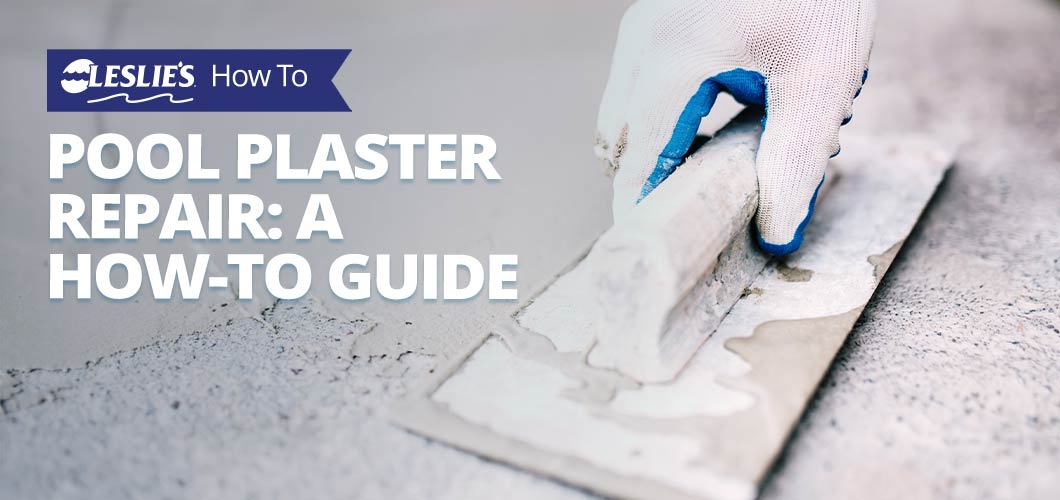
Pool Plaster Repair: A How-To Guide
If you own a concrete pool that’s coated in plaster, it’s inevitable that you’ll eventually have to make repairs. Plaster is a key component of your inground pool, and it prevents water from leaking through and possibly damaging the structural pool shell underneath. As soon as you notice any issues, including pits, stains, cracks, or delamination, it’s important to act quickly to prevent much larger issues down the road. If this is your first time repairing pool plaster, don’t worry! We’ve got you covered. Keep reading for some helpful pool plaster repair tips.
Common Pool Plaster Problems
Many factors can impact the appearance and integrity of your pool plaster, including problems with water balance, poor cleaning and maintenance habits, wildly swinging weather patterns, ground shifts, and of course age. Depending on the blend of plaster you have, you can expect it to last anywhere from 10-25 years. It goes without saying that higher quality plaster mixes paired with proper pool maintenance tend to have a longer lifespan. Let’s take a closer look at some of the most common types of plaster damage in a pool.
BONUS TIP: It's not always age or pool maintenance that causes pool plaster to fail. Sometimes it has to do with the quality of the plaster mix and/or how it was applied. That said, maintaining proper water balance and keeping a regular cleaning routine will help your pool plaster look pristine for as long as possible. For more information about how to balance pool water and other common pool maintenance tasks, check out our other pool care blog posts.
Check Cracks or Crazing
These are very tiny cracks that appear in the surface of plaster. They’re most often noticed on top steps, which are exposed to longer dry times while plastering and filling the pool. Although not patchable, they can be sanded to reduce appearance.
Surface Etching or Corrosion
Common in most pools, these small surface irregularities are sometimes the result of improper plaster mixing or curing. This issue can also be caused by improper water chemistry, which erodes softer surface areas like plaster. Damage from etching and corrosion is not normally patched, but can be sanded.
Surface Deposits or Discoloration
Also common in most pools, calcium deposits mixed with dirt and oil can deposit on the waterline or in less apparent thin sheets over the entire pool surface. When mixed with metals, various colors will stain pool plaster. Organic material like leaves and lawn debris can also stain the bottom of the pool if you don’t keep up with a regular cleaning routine. Stains and discoloration can be removed with a professional acid wash.
Stress Fractures or Deep Cracks
Plaster cracks that are smaller than 1 mm often do not leak, but you can dye test them to confirm. Larger vertical cracks in plaster may be the result of structural stress. Horizontal cracks in the pool tile line are often caused by the pool deck pushing against the pool wall. Large cracks must be repaired as soon as possible.
Delamination or Pop-Offs
In cases of bond failure from old plaster to new plaster, hollow spots can pop off, creating small craters of various sizes. These areas can be quickly cleaned and repaired with Patch-It waterproof cement.
How To Repair Pool Plaster
Before getting started, you’ll need to gather a few essential items to fix the damaged pool plaster:

Cleaning and Surface Prep Supplies

Leslie's Patch-It All Purpose Waterproof Cement

Putty Knife or Grout Float

Grout Sponge
Pool Crack Repair
To patch a small pool plaster crack, the crack should first be cleaned to remove any grease or dirt that could affect the bond of the plaster patch. Remove any loose material, and if the crack is very narrow or shallow, it should be opened up slightly more to allow room for a good amount of plaster patching material.
When ready, mix up Patch-It waterproof cement according to label instructions. Use a putty knife or grout float to fill the crack, and feather the edges with a wet sponge. Patch-It works equally well for both dry and wet applications. If the repaired area isn’t already underwater, refill the pool immediately. You can also cover the patch with wet burlap to slow the drying of the plaster patch until the pool is full again.
PRO TIP: Patch-It is a great product for repairing small cracks and delamination areas in your plaster pool coating. However, very large cracks, major delamination, or signs of structural pool damage often require the attention of a licensed pool contractor or pool repair specialist.
Delamination Repair
To patch a plaster pop-off, first tap all around the patch while listening for hollow sounds, and remove any surrounding loose material. Clean the exposed area with a pool surface cleaner and degreaser, and then use a diluted acid to remove scale and roughen the surface. You can also use a simple one step product like Smart Seal Prep Wise Clean & Etch to prepare the surface. Remember to always wear gloves and protective eyewear when handling acidic chemicals. When done with the cleaning and etching process, hose the area to rinse completely. As above, mix up the needed amount of Patch-It according to the product label, and apply it to the area with a trowel or float. Follow up with a wet sponge to feather the edges.
Advanced Pool Plaster Repair Tips
While mixing and applying Patch-It is as simple as spackling drywall, there are a few tips that you may find helpful.
Color Matching
Your pool may look white, but plaster mix is whiter. You can add colorants or tints to a plaster mix, or simply dash a handful of sand across the surface or mix it in before applying.
Dovetail Cuts
When opening up a crack with a chisel or grinder, best practice is to apply a dovetail cut to the sides of the crack. This will allow the plaster patch material to grip into the crack more securely.
Rebar Rust
Rust stains on pool plaster are most often caused by rebar or rebar tie wires that are close to the surface. Cut out the area, and coat exposed rebar surfaces with an agent to seal the steel. Refill the area with Patch-It plaster repair.
Bonding Agents
Bonding agents are liquids that are added to cement mixes to improve adhesion to the substrate. They can be brushed into the crack before patching or added directly to the plaster mix in place of water. In most pool plaster patching scenarios, a bonding agent is not necessary. However, it may be needed for large delaminations on vertical surfaces.
Underwater Plaster Repair
A dry repair may provide better results because the area can be prepped and patched more easily. However, you can make repairs to small cracks and patch areas of plaster without having to lower the water. Larger underwater plaster patches may require more than one application.
Mix Patch-It with enough water for a stiff but workable batch, and form it into a ball shape for delaminations or a cylindrical shape for filling cracks. Allow 3-5 minutes for it to set up to a firm consistency before taking it underwater. When ready, put on your goggles and press the plaster patch into the hole or crack. Use a trowel or grout float to flatten the patch, then use a grout sponge to feather the edges.
If you ever have questions about repairing your plaster pool, we can help! Take a picture of the damage, and bring it by your local Leslie’s store. Our team of friendly pool pros will help you figure out the best approach for fixing up your pool plaster.